A thank you note
November 25, 2014
This week marks the end of my 40-year career as an elected official in the City and County of Los Angeles.
Twenty years ago this month, I was sworn in as a member of the Board of Supervisors. On that day, I spoke of the huge challenges facing our county and of my promise to hit the ground running. I’d like to think that, as I pull up a seat today for my final board meeting, I kept pace with my aspirations and, more importantly, with your expectations.
I want you to know what a privilege it has been to serve you, both on the Board of Supervisors and as a member of the Los Angeles City Council for two decades. I’ve never taken these jobs or your trust for granted. I’ve always worked as hard on the day after an election as I did on the day before.
In recent weeks, I’ve been honored at a number of farewell events. But make no mistake, while I’ve been flattered by these gatherings, I’m under no illusion about where the real credit should go—to you, my constituents.

The supervisor during his first successful run for City Council in 1975. He'd serve there for two decades.
You entrusted me with elected office as a young man two years removed from graduate school, and you empowered me with a mandate to shake up the status quo and the forces that benefited from it. Throughout my career—whether I was confronting brutality in the Los Angeles Police Department, battling gender discrimination in the workplace or challenging the dysfunctional structures of government—you’ve had my back. My success was the direct result of your support.
Together, we’ve made lasting inroads across so many fronts, for so many people. With my superb and hardworking staff, we’ve created a widening mass transit infrastructure, preserved the Santa Monica Mountains for future generations, bolstered our public healthcare system, provided permanent supportive housing for the homeless, enhanced our cultural institutions and restored fiscal stability to our county. So I leave office satisfied that I have given my all on your behalf.
As for the future, I will continue to contribute my voice to the crucial issues that impact our region and its quality of life, albeit not from political office. I plan on writing a memoir, doing some teaching and being open-minded to whatever the future may hold. After so many years devoted to my work, I also plan on spending more time with my young grandchildren and, of course, with my wife and partner, Barbara, who did far more than her fair share of supporting my career and of raising our daughter and son.
On this Thanksgiving, perhaps more than any other, I’ll be reflecting on the incredible joys and rewards of my life. I take with me so many fond memories of the work we’ve accomplished together to make this a better city and county.
I thank you from the bottom of my heart.
Zev
Helping homeless families heal
November 24, 2014
Gabriele Gonzalez was living a hard life last winter. She was homeless and addicted to methamphetamine, sleeping in parks and abandoned buildings, unsure where she’d find her next meal.
Today, she’s headed in a dramatically different direction. She lives in a comfortable room in a freshly-refurbished residential treatment center, has a new job in customer service, and is looking forward to a possible reunion with the three children—aged 6, 8 and 10—who were taken away from her when she was at her lowest point.
Her transformation has not been a solo voyage. Crucial assistance is coming from the Via Avanta Residential Center in Pacoima, where a pilot program called “Project 60: Women and Children” is underway to help homeless women, particularly mothers, with serious mental illnesses.
The program marks the latest extension of Project 50, a pioneering “permanent supportive housing” program launched by Los Angeles County in 2007. It provided 50 of the most vulnerable homeless people on Skid Row with housing first, and then surrounded them with mental healthcare, substance abuse treatment and other services. Project 50-style programs have since expanded to assist nearly 1,000 people across the county, said Mary Marx, who oversaw the initial effort for the Department of Mental Health. The initial investment paid off, too—saving $4,774 per person over the first two years by keeping them out of jails and emergency rooms. And the model has spread to cities including Denver, San Francisco and Washington, D.C.
And, of course, to Pacoima, where for many in the women’s pilot program, the well-being of their children serves as a powerful motivator to turn things around.
“I had lost apartments, cars and jobs before, but I had never lost my kids,” said Gonzalez, 29, whose son and two daughters were removed last November by the Los Angeles County Department of Children and Family Services and placed with relatives. “When they got taken, I lost a big part of me. I couldn’t imagine having them grow up with the idea that I didn’t fight for them.”
At a court date last January, Gonzalez realized that she was running out of time to get her kids back. Motivated to take action, she turned to a list of help numbers provided by DCFS and decided to call Via Avanta, which is run by Didi Hirsch Mental Health Services. She moved in on February 5, 2014.
Kita Curry, president and CEO of Didi Hirsch, said that having children involved presents special challenges and raises the stakes of the housing program.
“We’re not just helping an individual get their life together; we’re helping a family get their future together,” Curry said. “Otherwise, these kids would be at risk of trouble at school, getting in bad relationships and repeating the cycle.”
Supervisor Zev Yaroslavsky—an early supporter and pioneer of the housing-first approach—identified $542,000 in 3rd District homelessness funding to refurbish one of two residential buildings at Via Avanta last year. Last month, he directed an additional $1.7 million to the facility to redo the second building.
Though only a year old, the women’s program already is making a difference. It has served 39 women since the beginning of 2014. All were homeless and suffered from severe mental illness. Many also came with substance abuse disorders. Some, like Gonzalez, no longer had custody of their children. Others were admitted with children in tow. So far, 16 have been discharged and 23 remain in treatment. Of those discharged, 88% went on to live in supportive housing or with spouses, family and friends. Half moved out with their children and the others continue to work toward reunification.
Unlike Project 50—which dealt with single homeless people, most of them men—this program must consider the safety of the children and the realities of parenting, Curry said. Raising kids can be stressful even without mental health issues and substance abuse challenges, so it’s important to ensure that the women can cope with those realities before they are discharged.
After moving in, Gonzalez felt an immediate sense of security knowing that her basic needs would be met. She began putting her life back together, piece by piece—going to group therapy sessions, working in the kitchen and attending classes on subjects such as parenting, safety, domestic violence and relapse prevention.
“At first I was very emotional,” Gonzalez said. “I would cry in every group. It was part of my healing process.”
After a month or so, Gonzalez was allowed to have visitors, but she first needed to mend the bridges she had burned with members of her ex-husband’s family, who have custody of her children. The kids now visit occasionally, and Gonzalez has tea parties, plays dress-up and reads to them. She’s seen them “about 10 or 11 times. I’ve had to sit back and be OK about the fact that I’m not going to get as many visits as other people, but I‘m doing what I can.”
In addition to working on mental health and substance abuse issues with counselors, she built a resume and did mock interviews at Chrysalis, a nonprofit employment agency that works with Via Avanta. After spending hours each day applying for jobs at the work center’s computers, three weeks ago she was hired to do customer service for online companies. She wakes at 4 a.m. each day to commute from Pacoima to her workplace in Glendale. In her spare time, Gonzalez plays piano and even sings in Via Avanta’s hallways. Her current favorite is “Someone Like You” by Adele.
Gonzalez is adamant about taking responsibility for her life, but, like many homeless women, she also must come to terms with a long series of youthful traumas, including rape, molestation and abuse. By 15 she was diagnosed with clinical depression. Married at 18, she spent the next 12 years in a troubled relationship and turned to drugs, she said, to deal with her inner pain.
At first, she was reluctant to accept help in coming to terms with her past.
“I guess I held that stigma that I’m crazy if I have to see a therapist,” Gonzalez said. “I was very anti-medication. But it made such a difference. The medication and therapy has helped me so much.”
Now she’s looking ahead to the new year. February looms as an important month. That’s when she expects to move from Via Avanta (the program is generally geared to short-term stays) and has a custody hearing scheduled on the 15th.
“Hopefully that will be the date that I reunite with my kids,” she said.
Someday, Gonzalez hopes to attend nursing school and help other women like herself, perhaps at a place like Via Avanta. But she doesn’t want to get ahead of herself. She planes to continue focusing on her mental health and substance abuse issues by staying in treatment and going to 12-step meetings.
“I’ve put in a lot of work but none of it would have been possible if I hadn’t come here,” Gonzalez said. “I’m looking at life in a new way. I love myself today.”
Posted 11/21/14
D.A. sees new day for mentally ill
November 20, 2014

District Atty. Jackie Lacey tells the Board of Supervisors that jail diversion is “right within my mission.”
When Jackie Lacey won election as district attorney in 2012, no one expected the county’s chief prosecutor to become a crusader for taking people out of—rather than into—jail.
Yet this month, she was again center stage before the county Board of Supervisors to push for sweeping, if gradual, reforms to provide the mentally ill with alternatives to incarceration.
“Too often, our default position is to lock mentally ill people away because of a perception that there is no alternative,” Lacey said. “Well, there are alternatives — we just need to dedicate resources to expanding the capacity of those alternatives.”
Flanked by leaders of the county’s criminal justice system and social safety net, and with advocates for the mentally ill sitting in the audience, Lacey vowed to present a comprehensive report on diversion programs in early 2015.
She emphasized that initial goals for the Criminal Justice Mental Health Project should be “modest and achievable.” Progress, she said, would take time.
“I want to temper our expectations for a quick fix,” Lacey told the board, pointing out that the county is so large and complex that it’s “a country unto itself.”
Still, there is a sense of urgency to the undertaking, not just for mentally ill inmates whose conditions are worsening behind bars. The U.S. Department of Justice has accused the county of failing in its constitutional duty to adequately serve mentally ill inmates and will likely force the county into a court-supervised federal consent decree.
Although the board is weighing a $1.7-billion proposal to replace Men’s Central Jail with a Consolidated Correctional Treatment Facility, envisioned as “a treatment facility for inmates, construction won’t be completed for years.
The county does have diversion programs already in place for the mentally ill but none has the capacity to serve the vast numbers of people whose schizophrenia, paranoia, bipolar disorder and other conditions may cause them to run afoul of the law. An estimated 15 percent of county’s 20,000 inmates have been diagnosed with a mental illness.
A pilot program was recently created to provide permanent supportive housing for 50 chronically homeless, mentally ill people who’ve been arrested for low-level offenses in the San Fernando Valley. Championed by the office of Supervisor Zev Yaroslavsky, the Third District Diversion and Alternative Sentencing Program is envisioned as a potential template for diversion programs countywide.
Currently, the Department of Mental Health has only three psychiatric urgent care centers and three crisis residential treatment programs across the 4,000-square mile county, and 30 mobile crisis support teams to respond to emergencies, sometimes while partnered with sheriff’s deputies or police officers.
Thanks to a $40.1-million state grant, however, those services will soon be expanded. The board voted to double the number of its urgent care centers, and potentially multiply its crisis residential treatment programs tenfold. It authorized creating 11 more mobile crisis support teams.
In an interview, Mental Health Director Marvin Southard said only those who are not considered a danger to society would be eligible for diversion.
“If somebody has committed a serious crime, they need to pay the consequences,” he said. “Whether they happen to be depressed is really beside the point.”
DMH also has mental health professionals embedded in 22 courthouses, but Lacey acknowledged that some prosecutors and public defenders don’t utilize their services or even know they exist.
She said officers of the court, as well as law enforcement officers, need additional training to ensure the mentally ill receive treatment, instead of ending up behind bars. She said that training would be the “short term” goal of the Criminal Justice Mental Health Project.
County Supervisor Zev Yaroslavsky believes that having Lacey spearhead the county’s diversion efforts is a “game changer.”
“It’s one thing for a non-law enforcement officer to advocate for this sort of thing, but it’s another when one of the chief law enforcement officers in the county — in this case, the D.A. — gives this the imprimatur of acceptability,” he told her after her recent testimony.
“I think this will be a real revolution for the county,” he said. “And I hope that we have the political will to get it done.”
In an interview after her board appearance, Lacey said she sees diversion programs as being “right within my mission.”
“My mission is to seek justice,” she said. “The stories of people who have loved ones in jail, or who have been put in jail themselves while mentally ill, just speaks to me personally.”
Posted 11/20/14
Piloting a path away from jail
September 18, 2014
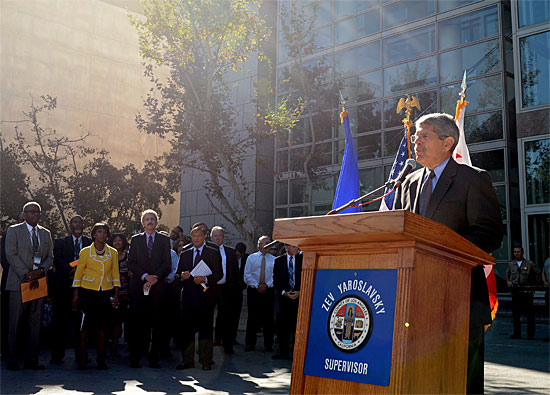
Supervisor Zev Yaroslavsky announces the creation of a new jail diversion program, with Dist. Atty. Jackie Lacey, in the yellow jacket, among those in attendance.
Confronting a jail system packed with rising numbers of mentally ill inmates, an unprecedented coalition of criminal justice and social services agencies have rallied behind an initiative that stresses rehabilitation over punishment for certain low-risk offenders and holds out the promise of reduced recidivism.
Eleven agencies—including the Superior Court and the offices of the district attorney, city attorney and public defender—are collaborating in the pilot project, orchestrated by Los Angeles County Supervisor Zev Yaroslavsky as a way to provide chronically homeless and severely mentally ill individuals with a carefully proscribed path out of jail and into recovery.
“I believe this is a more intelligent way of dealing with people like this, rather than putting them in jail, which is a far more expensive and less effective way to address mental health issues,” Yaroslavsky said during a Wednesday news conference at the Van Nuys courthouse.
“This program is going to start here, at the Van Nuys Courthouse and at the San Fernando Courthouse, but it could easily be placed in Compton, in Pomona, in Inglewood, Santa Monica, anywhere,” said Yaroslavsky, who allocated nearly half of the initiative’s $750,000 price tag from his district’s discretionary funding.
Among those who stood alongside the supervisor for Wednesday’s announcement was Los Angeles County Dist. Atty. Jackie Lacey. In recent months, she has become the leading proponent of alternative sentencing for low-risk mentally ill offenders, whom she says have little chance of success inside the county’s overcrowded lockup.
Lacey called the incarceration of such defendants, who suffer from bipolar disorder, schizophrenia, post-traumatic stress syndrome and other mental illnesses, an “unconscionable waste of human life and money.”
The new Third District Diversion and Alternative Sentencing Program will, under a series of specific conditions, provide 50 eligible participants with a variety of wraparound services—including permanent supportive housing and mental health treatment—intended to keep them off the streets, out of jails and emergency rooms, and put them on a path to self-sufficiency. Those services will be arranged by the non-profit San Fernando Valley Community Mental Health Center.
Under the program’s protocols, prosecutors and public defenders will collaborate with psychologists to identify severely mentally ill—but nonviolent—chronically homeless individuals eligible for the program’s shelter, counseling, medication management and other services, including employment and vocational assistance. A judge must approve the defendant’s participation.
Eligible misdemeanants will undergo treatment for 90 days and pay restitution, if necessary. Charges will be dismissed after the successful completion of the program. Otherwise, the criminal case will proceed.
Eligible felons, meanwhile, will be required to plead guilty or no contest to the charges against them and undergo treatment for 18 months, with case managers and probation officers regularly checking their progress. They also will have to pay restitution.
“What I like about this program is it does have a lot of leverage with participants,” said Adrian Sheff, director of adult and older adult programs at the San Fernando Valley Community Mental Health Center. “They’re not just being diverted from jail and told to bring a note back from their treatment provider to say they completed the program. Instead, there are ongoing reports, feedback with the court and probation and other measures to ensure they won’t wind up back in jail or commit new offenses.”
City Atty. Mike Feuer, whose office prosecutes misdemeanors, agreed during Wednesday’s event that jail is the wrong place to deal with severe mental illness. He said the pilot program’s more “innovative and humane” approach will keep neighborhoods safer.
Said Superior Court Presiding Judge David Wesley: “It is sometimes in the best interests of the public, and of mentally ill offenders, to divert someone from the criminal justice system.”
Los Angeles County Mental Health Director Marvin Southward said he hopes the pilot program marks the beginning of lasting reforms in the way the criminal justice system treats the severely mentally ill and chronically homeless.
“I think we have to show that by investing in an intensive program like this, we could produce good enough outcomes and save enough money that it’s worth spreading this model to other places.”
Posted 9/18/14
A force of our best nature
August 21, 2014
Cynthia Langley is no quitter. Lives depend on that.
A social worker for more than three decades, Langley fights chronic homelessness one weary soul at a time, spending day and night trying to persuade the most entrenched residents of the street to give housing a chance. She’s never welcomed with open arms. But in the end, she receives enough hugs of gratitude to keep her spirits strong.
“Someone has got to reach out to these individuals. They’re somebody’s son, somebody’s brother, somebody’s cousin, somebody’s loved one,” says the 58-year-old Langley, herself a grandmother of four. “And I’m stubborn enough not to take no for an answer.”
Earlier this year, I called upon Langley’s employer, the miracle-working Step Up on Second, for help on a case that would take every ounce of her stubbornness and devotion.
For more than a decade, a homeless man had taken over a bus shelter on Beverly Boulevard at Gardner Street near the Fairfax area. Over the years, he’d amassed a rising mountain of boxes and bags. The situation was no longer acceptable—for him or the community.
I knew that if anyone could get him off the street it was Step Up on Second, a Santa Monica-based nonprofit that provides permanent supportive housing to the most vulnerable of our homeless population. In fact, I’d recently allocated county funds to the organization to expand its outreach into the Beverly corridor, an area of increasing homelessness. Langley was brought aboard with that money and would soon come face-to-face with one her toughest challenges—a 64-year-old man who’d come to be called the “Professor.”
What happened during the next four months is both inspiring and instructive—a real-life look at what it actually takes to bring about the first steps in a long journey of recovery. It’s a remarkable story of skill, perseverance and trust, one with a happy beginning but no promise of a satisfying ending. That simply is the reality we face in trying to coax the homeless into homes, especially those who, like the Professor, are battling mental illnesses.
Langley says the first time she met the Professor at his bus stop, he was sitting, as usual, with his back to the street, keeping an eye on his belongings piled high behind the shelter. It was a chilly morning and he was wearing a big brown coat. “He turned around slowly with an angry, suspicious look,” she recalls. After Langley explained why she was there, the Professor said flatly: “I’m not interested.”
“Would you mind if I came back?” Langley asked. He turned his back on her. But she returned anyway, day after day, always deferential. “I know you’re busy,” Langley would say, “so what times work for you? What do you prefer?”
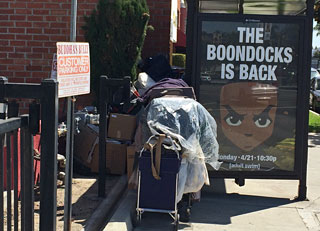
The Professor's belongings at Beverly Boulevard and Gardner Street, before he moved into his own apartment.
Soon, the facts of his life started slowly unspooling: He was born in Germany. He was physically abused by his father. He immigrated to the U.S. as a teen with his family. He went to UCLA and earned a bachelor’s degree in military science and a master’s in medieval history. He served in the Army. He never married. He even worked as
an adjunct professor at UCLA (hence the respectful nickname bestowed on him by Step Up on Second.)
Eventually, he began sharing with Langley the rituals of his daily life. He told her he’d spend hours at the neighborhood Starbucks. He’d clean up in the bathrooms at Pan Pacific Park, across the street from the bus shelter. Nice people would regularly bring him food and clothing. He’d been living this way, he said, for 14 years.
It also became clear to Langley and the team at Step Up on Second, including program director Dr. Michael Marx, that the Professor was distrustful and erratic. One day he’d be cooperative, the next combative, launching into diatribes and rants. He worried that the Starbucks was bugged.
Langley says she tried to stay mindful of the professor’s delicate mental state. She’d make sure to ask him, for example, whether it was all right for her to take a few notes as they spoke. That way, he wouldn’t think she was scribbling secret things about him to give to the government. Sometimes, he’d get racially provocative. “You’re African American,” he’d say to Langley, “what do you know?” But Langley would say calmly, without a hint of the irritation she felt: “Everyone has a right to their opinion.”
Always, she’d steer the conversation back to the primary objective.
“You’re just another one of those people who think they’re going to get me housed,” he’d say. “You’re right,” she’d answer. “I’m going to keep trying. I really do care about you and I’d like to see you living in a comfortable place. One day, I can imagine you housed. Can you imagine that?”
“No,” he’d respond. “I’m always going to live on the street.”
Still, he was continuing to open up. He eventually gave Langley a link to his past, a friend from his UCLA days with whom he’d once lived just a few miles away—the last home the Professor would know.
When Langley and Marx visited the friend, he said the Professor had been seriously hoarding and he had no choice but to ask him to leave, although they remained in contact. The friend, now in his 70s, also gave Langley and Marx an old datebook the Professor left behind, containing, among other things, his social security card, his honorable discharge from the Army in the 1980s and photos from years back.
Finally, in May, a breakthrough came when Langley and Marx asked the Professor if he’d like to see the Hollywood apartment that, just in case, had been reserved for him at a place called Michael’s Village. To the amazement and elation of the Step Up on Second team, he agreed to get in Langley’s car and go. When they walked inside, Marx took the lead.
“You’re a professor, can’t you imagine yourself sitting here writing?”
“Yes, I could,” the Professor responded. “This is for me?”
“This is your unit.”
“It’s too good to be true,” the Professor said.
“It is good, and it is true,” Marx assured him.
As Langley listened to the conversation, one thought kept going through her mind: “We got him.”
In the weeks ahead, there’d be more challenges to moving the Professor into his apartment. At one point, he changed his mind and vanished for a few days. But his old friend helped bring him back into the fold. He also suddenly became distrustful of Langley, who knew better than to personalize a snub rooted in mental illness. In fact, when it came time to sign the housing contract and other paperwork, Langley went so far as to duck under her desk so she wouldn’t agitate the Professor and send him back out the door.
The Professor finally moved into his unit at Michael’s Village earlier this month. Now, of course, comes the really hard part. Marathoners have a saying that the course is divided into two halves—the first 20 miles and the last 6, the most grueling stretch. That seems an apt description for the difficulties the Professor will confront as he tries to adjust to a roof over his head and neighbors all around him. He is no longer slipping through the cracks.
Fortunately, although he’s got a good distance to go, he’s finally on course—with a committed and compassionate team behind him, coaching him along the tough road ahead.
As for Langley, she’s already focusing her energies on a homeless man about a half-dozen blocks away at First and Detroit streets.
“I think we got him,” she says.
Posted 8/21/14
Embracing a second chance
November 25, 2013
Gratitude is rare in criminal courtrooms, but for the women gathered on a recent Friday before Los Angeles Superior Court Judge Michael Tynan, thanksgiving was everywhere.
One was clean after an addiction that had crippled her since age 7. Another was in sober living after 30 years of shuttling between Skid Row and prison. Yet another was a middle-aged ex-con when she hit her deepest bottom, and she wept as she described the redemption she shared with the five women beside her.
“I was so tired,” 55-year-old Donna Majors said last week, as prosecutors and parole officers brushed away their own tears at the small graduation ceremony in Tynan’s downtown courtroom. “And I was given the chance to finally face my demons, to know who I am and finally be at peace.”
If the emotional scene seems a far cry from standard L.A. criminal justice, it may be because the program that spawned it is a departure as well. Since 2007, the Second Chance Women’s Re-Entry Court has been among the most successful diversion programs in Los Angeles County, offering an intensive yet cost-effective alternative to prison for hundreds of high-risk female felons.
The program targets parolees and probationers charged with new offenses, channeling them into a 6-month residential substance abuse treatment program in lieu of another term behind bars. That rehab, at the nonprofit Prototypes residential center in Pomona, is followed by up to 18 months of tightly supervised outpatient treatment, plus services ranging from parenting classes to educational and vocational training.
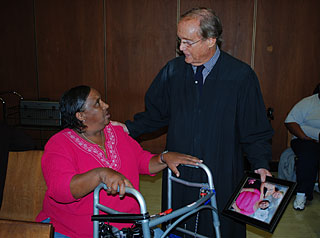
Judge Tynan greets program alum Georgina Moore, who presented him with a picture of her and her daughter.
Each woman checks in regularly before Tynan, who consults with therapists and court officers to determine when a participant can move to the next level of treatment. Those who relapse or reoffend return—often remorsefully—to county jail or prison, but most move on to sober housing, family reconciliation and even jobs and college.
At last count, 295 women had been formally admitted and 61 had gone back to jail or prison, according to a recent review conducted by the Public Defender’s Office. About 90% of the recidivists, the review found, were women who had not yet completed their treatment.
Of the 125 who have graduated so far, the review found, only eight—about 6%—have since gone back to jail or prison. By comparison, according to state figures, the recidivism rate in 2011 was 55.1% for female inmates.
“You’ve come a long way,” the judge told a glowing ex-con at the most recent graduation ceremony, glancing at a file that included her latest report card from Mt. San Antonio Community College. “You got an A at Mt. SAC! Congratulations! Gimme a hug! I remember when you came through that door looking like something the cat wouldn’t have dragged in on a bet.”
Well into his 70s, Tynan notes that he could be retired. But the judge—who also presides over the county “drug courts” and alternative sentencing programs for the mentally ill, military veterans and others—says that his is a labor of love.
This has been particularly true lately, he adds, as funding concerns have been looming over the program because of a new state law aimed at putting the brakes on California’s burgeoning state prison population. Under the AB 109 law, known as “realignment,” the county, rather than the state, has been given responsibility for supervising and incarcerating offenders whose most recent convictions are for non-serious, non-violent, non-sexual offenses.
But because the Women’s Re-Entry Court is largely underwritten by a state grant for parolees, women who once were prime candidates for the program—street people, hustlers and others whose long criminal histories stem from drug habits—are now ineligible because the state no longer supervises them.
And the county, which now oversees these offenders, doesn’t directly fund its Re-Entry Court participants. Under AB 109, these offenders are being channeled into other, less intensive programs underwritten by realignment money. If they re-offend now, they can only be placed in Re-Entry Court if an alternative funding source pays for their treatment—a grant for AIDS patients, for example, or for pregnant women.
Meanwhile, officials say that parolees who remain under state supervision now often require special consideration to get into the program, because they are more institutionalized, with more serious convictions.
Shari Crome, an assistant unit supervisor with the California Department of Corrections and Rehabilitation, says she’s frustrated “because I’ve been here almost since the beginning of the program, and I’ve seen the successes. There’s nothing else like it in the state, and it works.”

Deputy Public Defender Nancy Chand, a key member of the re-entry court team, congratulates the grads.
Deputy Public Defender Nancy Chand, who has represented most of the Re-Entry Court women, calls the AB 109 funding snag a rare sour note in a program that has transformed some of the most desperate lives in L.A.
“These women are really scarred,” Chand says. “Most come in with horrific trauma, and were victimized as children, enduring severe physical, sexual and emotional abuse and abandonment. Some can’t read and write. Some can’t work. Eighty-one percent have one or more mental health diagnosis and 50 percent have two or more. As one of my clients put it, they’re literally scraped off the streets.”
Currently, Tynan says, about 60 women at any given time are enrolled in the program, a little more than half of them paid for through the $500,000 annual state correction’s grant and the rest covered by a shifting and uncertain patchwork of federal, state and county grants to Prototypes.
The cost is about $18,000 a year for each woman, versus an incarceration cost of close to $50,000 a year in prison or more than $36,000 a year in county jail, not counting medical and mental health care. Officials at the Public Defenders Office estimate the program has saved tens of millions of dollars; many of its participants had been facing jail or prison sentences of 10 years or more.
Barbara Dunlap, for instance, was a 58-year-old homeless addict with 15 prison terms under her belt by the time she entered the program.
“I discovered alcohol before I started school, and I started school at the age of six,” Dunlap says. Her babysitter sold her to men when she was a child and by 21, she says, she was a prostitute with a criminal record. By the time her public defender sent her to Tynan’s courtroom, she was a 58, suffering from AIDS and hepatitis and was wheelchair-bound as the result of surgery stemming from a poisoned heroin injection.
Now 61, she is sober, living in permanent supportive housing, enrolled in college classes and a mentor at Prototypes. And at the ceremony in Tynan’s courtroom, she addressed the most recent graduates from her electric wheelchair, rolling back and forth across the courtroom, testifying like a preacher as a dozen state corrections officials watched from the jury box.
“When they found me, I was on the streets, and I don’t even know how they told me from the sidewalk—I was cold, my life was filled with stench and I was gray, without any life in me,” she proclaimed, her voice trembling.
“But they treated the whole woman—my health issues, my substance abuse issues, my anger issues. I didn’t know that anyone understood people like me.”
Taking the podium in Dunlap’s wake, the graduates told their own harrowing stories, weeping with gratitude as they thanked their therapists, probation and parole officers, prosecutors and defenders, families and, of course, the judge.
Brigitte Benjamin, 52, told the group that she had spent 30 years on Skid Row, and had expected to die there. Now, she is in a sober living facility and working toward her GED after 30 years on Skid Row.
Helen Navarro credited Tynan and Prototypes with forcing her to confront the roots of her addiction for the first time in the 20 years she had spent cycling in and out of prison on robbery and burglary charges. “I didn’t want to go deep-deep-deep,” said Navarro, a 51-year-old recovering crack addict—now sober and working as a receptionist at a country club in the San Gabriel Valley. “The counselors made me look at myself.”
Sandy Raymond, a 48-year-old mother of two who had lost more than half her life to crack addiction, did a little dance as Tynan handed her a certificate of completion. “I didn’t know nothing but going in and out of jail and stealing stuff,” she said. “But now I’m a secretary. I love my life.”
Over cupcakes and high fives from their families, the women also quietly gave thanks for the inner strength they were able to muster.
Brandishing her graduation certificate after decades of crime and addiction, Mary Willis said that for the first time in 25 years, she now has a relationship with her children. “I will always keep in the back of my mind what Judge Tynan told me,” she said proudly. “Give yourself a chance.”
Posted 11/25/13
A breakthrough for vets
August 2, 2013
A few years ago, I was participating in the county’s biannual homeless census when I came upon a man sleeping under a bush on La Brea Avenue. It was winter, about 4 a.m. The man had been on the streets for ages. He shivered awake, and we talked for a few minutes, his breath steaming the night air, his clothing disheveled. Among other things, he told me he was a veteran.
That conversation was as heartbreaking as it was emblematic. More than 6,000 of Los Angeles County’s homeless are former military servicewomen and servicemen. Once, they volunteered to give their lives for their country. Now they wander our streets, their minds and bodies often addicted or damaged, their chances higher than average of ending up in the ranks of long-term street people at massive public expense.
That’s why, two years ago, we partnered with the Department of Veterans Affairs to launch a pilot program, a spinoff of our successful Project 50, to provide permanent supportive housing for a group of veterans identified as most likely to die on the streets.
There were 60 to start, severely mentally ill and chronically homeless. And, as with Project 50 on Skid Row, our veterans initiative, dubbed Project 60, started with the premise that if you give someone housing first—no moralizing, no demanding that they get a job or sober up as a condition of shelter—they’ll be more amenable to any medical, mental health or substance abuse treatment services you offer. That, in turn, will spare taxpayers the much higher cost of housing them in hospitals and jails.
It was a novel idea, and today, I am thrilled to report that it has paid off.
This week, during a meeting in Washington, D.C., with U.S. Sen. Dianne Feinstein, Rep. Henry Waxman and myself, Secretary of Veterans Affairs Eric Shinseki committed to dramatically scaling up the program, which, according to this year’s homeless census, contributed to a stunning 23% drop in the number of homeless vets over the last two years in Greater Los Angeles.
The VA’s commitment—part of the Secretary’s long-stated goal of ending homelessness among veterans by 2015—will fund and support a sweeping expansion of homeless services for veterans in L.A. County, from housing vouchers to medical outreach to a dedicated homeless services center at the West Los Angeles VA facility.
In all, it will allow us to house and treat more than ten times as many homeless vets in the next two years as we did over the last two. During this period, we expect to house 1,320 chronically homeless veterans. This represents the single most significant development on this issue in years.
It’s also the result of a lot of hard work and collaboration by Sen. Feinstein, Rep. Waxman and staff including Donna Beiter, who directs the VA’s Greater Los Angeles Healthcare System, the VA’s Michelle Wildy, Flora Gil Krisiloff in my office, Mary Marx with our county Department of Mental Health and front-line nonprofits Ocean Park Community Center in Santa Monica, St. Joseph Center in Venice, San Fernando Valley Mental Health Center and the Hollywood branch of Step Up on Second.
And it’s proof that when we build on our successful programs, we can make a life-saving difference. We have helped nearly 120 homeless mentally ill veterans through our original Project 60: a sailor who spent the past 15 years sleeping in a Santa Monica park and making monthly emergency room visits until he got housing; a former Marine who, after a decade, has begun to get sober in her Gardena apartment; a Vietnam vet, dying of cancer in a hospice, who came in from the night in time to make peace with his anguished family. Now the number being cared for will dramatically increase.
These veterans answered the call of our country when we needed them. Now they need us, and this week marks a huge breakthrough in helping Los Angeles answer that call.
Posted 8/3/13
The chair recognizes…
December 6, 2012
With my final term as chairman of the Los Angeles County Board of Supervisors ending this week, I’ve been reflecting on some of the challenges—and accomplishments—of the past year. I know there’s no shortage of tough issues ahead. But it’s healthy, I think, to take stock of our progress, too.
For starters, the Board of Supervisors this year aggressively moved to fix the seemingly intractable problems in the Department of Children and Family Services. Earlier, last February, amid an uproar over a number of high-profile child deaths and questions about the department’s forthrightness, we named Philip Browning as DCFS’s new director. By all accounts, he has brought a new level of accountability and creativity to the department.
At the same time, the board set the stage for major changes in First 5 L.A., the organization responsible for making sure that voter-approved tobacco tax revenues are being effectively spent on improving the lives of our children from birth to 5 years old. We’ve brought in a new executive director, Kim Belshé—former head of the state Health and Human Services Agency—who’ll ensure that unspent surpluses will no longer build in the group’s bank accounts while youngsters are in need.
We also confronted another problem that was eroding public confidence in the integrity of our local government—brutality by sheriff’s deputies assigned to the Los Angeles County jail system. Late last year, the board created the blue-ribbon Citizens’ Commission on Jail Violence with a mandate to pull no punches in assessing responsibility for the violence and in offering ways to bring it under control.
This September, the panel returned with a verdict, placing blame for these unacceptable breaches of public trust at the highest levels of the department and recommending more than 60 reforms, which are now being implemented. This week, we appointed the commission’s general counsel, Richard Drooyan, to oversee this effort.
On another front, this year marked a watershed in the county’s battle against chronic homelessness.
As perhaps many of you know, I’ve championed a program called Project 50, aimed at providing permanent supportive housing to those most likely to die on the streets of Skid Row. This highly successful effort, which has been replicated throughout my district, served as the foundation for the creation of the Los Angeles County Interdepartmental Council on Homelessness. Last month, the council adopted our first-ever blueprint of how to attack this problem in every corner of the county. Although funding will continue to be an issue, we’ve coordinated the resources and expertise of numerous county agencies that for too long were chipping away alone at this vexing human tragedy.
Transportation continues to be a preeminent issue in our region, and this year we marked a couple of milestones. The first leg of the Expo Line opened in April, bringing rapid mass transit to the Westside for the first time since the Red Car. It’s now attracting record numbers of riders and work on the second and final leg is now well underway to extend the line to Santa Monica. And in the San Fernando Valley, a new four-mile northward extension of the Orange Line opened between Warner Center and Chatsworth in June—giving riders of the popular rapid transit busway even more options and connection possibilities.
We also, at long last, righted some wrongs this year.
In a long overdue move, the board rescinded a World War II-era county resolution urging the forced relocation of Japanese American families to internment camps. “It’s never too late to do the right thing,” said my colleague, Mark Ridley-Thomas, the board’s incoming chairman, who authored the motion. I certainly agree, and I continue to hear from members of the Japanese American community about how meaningful this was to them. The board, at the recommendation of Supervisor Gloria Molina, also issued a formal apology over the so-called “repatriation” of people of Mexican ancestry during the Great Depression, another stain on L.A. County’s history. By recognizing and acknowledging these violations of human rights, we can, I hope, reduce the likelihood of repeating them in the future.
Finally, we continued to recognize and support the arts as a life-enhancing and economically vital part of Los Angeles County life—from the smallest organizations bringing dance, music or visual arts to children to glamorous, internationally recognized players like the Los Angeles Philharmonic and LA Opera, and venues like the Hollywood Bowl, the Natural History Museum and the Los Angeles County Museum of Art.
As Supervisor Ridley-Thomas assumes the chairmanship, I wish him and all my board colleagues a productive and fulfilling year. Together, I believe we can make 2013 an even better year in service of all the people of Los Angeles County.
Posted 12/6/12
Putting the fab in pre-fab on Skid Row
November 29, 2012
Architect Michael Maltzan builds museums and mansions. His latest commissions include an addition to the American ambassador’s residence in Paris, a new pier in St. Petersburg, Florida, and an arts center for Rice University. Architectural Digest hails his “visionary approach” and the New York Times has dubbed him “a darling of wealthy art world patrons.”
So what’s an acclaimed architect like Maltzan doing in a place like L.A.’s Skid Row?
You’d be amazed.
Maltzan, whose firm is based in Silver Lake, is helping to rewrite the playbook on designing housing for the homeless in Los Angeles. Over the past five years, his two projects for the non-profit Skid Row Housing Trust—the Rainbow Apartments and the New Carver Apartments, next to the 10 Freeway at Hope Street—have pushed the envelope of what it means to create shelter while fostering a healing sense of community.
Now he’s at it again, venturing for the first time into a project that will graft pre-fabricated housing units onto an existing, multi-use single-story building at 6th Street and Maple Avenue. A new “structural tray” atop the original building will support the network of 100-plus studio apartments being trucked in from a factory in Idaho, while also forming a kind of outdoor mezzanine with community gardens, jogging track, basketball court, yoga platform and shared kitchen, laundry and computer room spaces. Supportive services, including a ground-floor medical clinic, will serve not just the residents of the new Star Apartments, but also people who live in the surrounding community.
The first units won’t be installed until December and the building isn’t set to open until next spring or early summer, but already Maltzan’s design is being lauded for its “elegant composition of prefabricated blocks.”
The Star project represents “a big innovation,” says Mike Alvidrez, the Housing Trust’s executive director. He praises Maltzan for bringing “a very fresh, innovative way of thinking about buildings…in particular when it comes to how design can be influential in terms of helping people recover from homelessness.”
Creating social, communal interactions is a big part of the Star’s design. The homeless, Maltzan says, “live on the street all the time. We think that they must be very well adjusted to living in public, but the reality is, the only way a human being is able to survive in that kind of situation without any private life at all is to create that private life within themselves, and start to create a real shell around themselves and disconnect from culture and community around them.”
So unlike the old transient hotel experience, where “you felt like you were under surveillance” when you entered the lobby and then “disappeared into your room and were never seen until you came back out,” the Star is designed so residents will step onto a walkway or balcony when they leave their units.
“You are moving through a more social situation,” Maltzan says.
He’s also excited about his first foray into pre-fabrication. Using pre-fab methods to build multi-family housing is more economical, efficient and environmentally-friendly than traditional construction methods—and, contrary to old stereotypes, offers sturdier, easier-to-maintain living spaces, he says.
“It allows us to reach a higher level of quality for the same cost,” he says. “When I say higher level of quality, it’s not making it fancier. It’s making it better, more durable, and nicer to use when you’re in the unit.”
And looks matter—whether you’re building a 28,000-square-foot residence for a mogul like Michael Ovitz or a 340-square-foot refuge for someone used to sleeping on the street.
“A big part of our goal,” Maltzan says, “is to say that architecture and design and beauty are something that should be accessible to the full range of the population of Los Angeles County.”
Not everybody saw it that way, at least initially. After the opening of his first Skid Row Housing Trust project, the Rainbow, some people asked him:
“Why are you making these buildings look so good? Why are you making them so identifiable? That must be more expensive. Why aren’t you just housing these people?”
Maltzan disagrees—not just on the expense question but on the notion that good design is just for the privileged. And he’s heard the same thing from people who live in his buildings, including the Rainbow.
“I’ve been to that building many, many, many times. I’ve been there when people knew I was the architect and I’ve been there when people didn’t know I was the architect. And the thing I get again and again and again from that community is, ‘We live in a place that looks like something, as opposed to a place that looks like nothing.’ ”
The new approach to building for the homeless is part of an overall shift that emphasizes the value of creating “permanent supportive housing,” which provides not just a roof overhead but surrounds residents with vitally-needed medical, mental health and other services. Project 50, which targeted some of the most entrenched residents on Skid Row for such housing, is a widely-cited success story, praised for transforming lives and saving money.
The Star Apartments, the first pre-fab homeless housing complex in L.A., is expected to embody those principles—and perhaps provide a template for the future.
“I think we could use many, many more projects like this,” says Alvidrez, of the Skid Row Housing Trust.
For his part, Maltzan thinks important elements in the Star Apartments could work all over Los Angeles—and not just for a homeless clientele.
“I can’t wait to do another project like that,” he says.
Maltzan, 53, who grew up in Levittown, N.Y. and was educated at the Rhode Island School of Design and at Harvard, moved to Los Angeles in 1988. He and his wife, Amy Murphy, an architecture professor at USC now pursuing a PhD in the university’s School of Cinematic Arts, now live with their two children in Pasadena.
He considers L.A. “the most compelling laboratory for thinking about the future of cities and the future of architecture in relationship to those cities.”
And he thinks he sees a glimpse of the future in the homeless housing efforts now afoot.
“As a citizen in the community, it makes me feel optimistic that you can effect change in a positive way in what most people have said is an intractable dynamic, that homelessness just can’t be changed, that that community is lost,” he says. “That is not the case. You can effect real change.”
There’s also a sense of vindication for his profession as a whole.
“One of architecture’s responsibilities is to use its capacity to continue to move cities and communities forward. And that includes making very pragmatic and functional buildings, cost-effective buildings, but also buildings that look like something, that stand for something, that aren’t shy in creating iconic structures that are for the culture as a whole,” he says.
“It’s extremely important for us to make the very best for the wealthiest segments of our community as well as for the less privileged in our communities. And it’s only when we work in all of those segments that you have any hope of creating a viable, sustainable, progressive metropolis.”
Posted 11/29/12





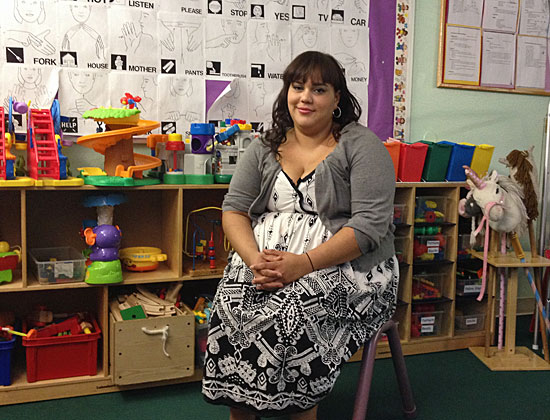
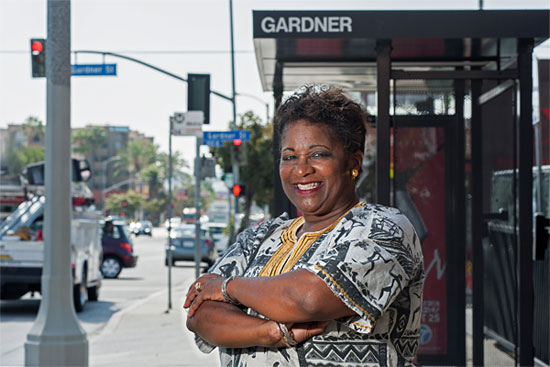
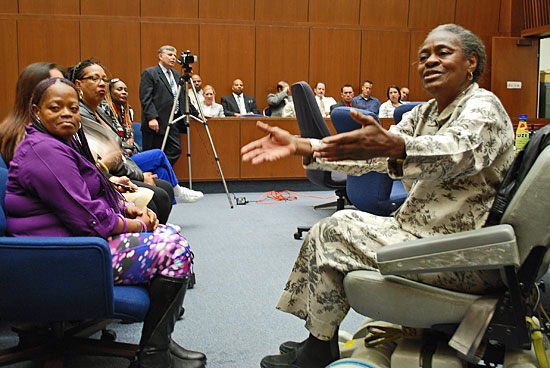

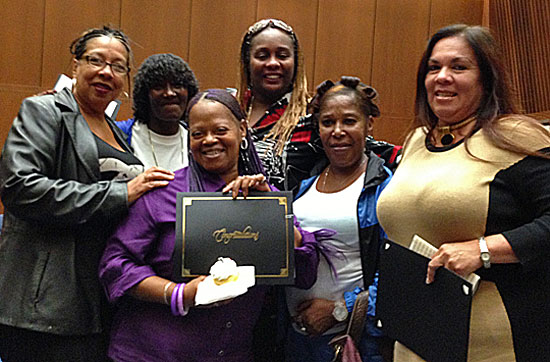
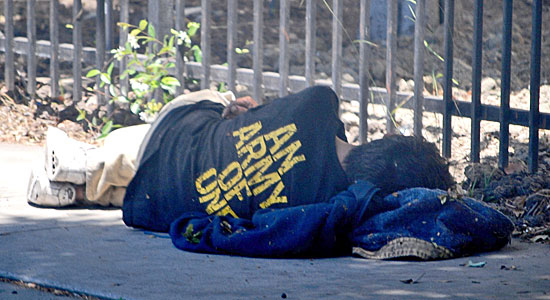

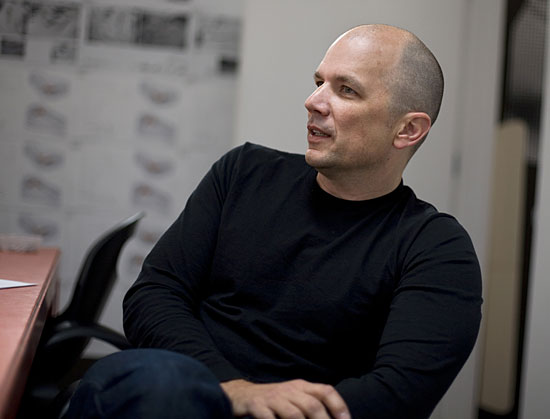

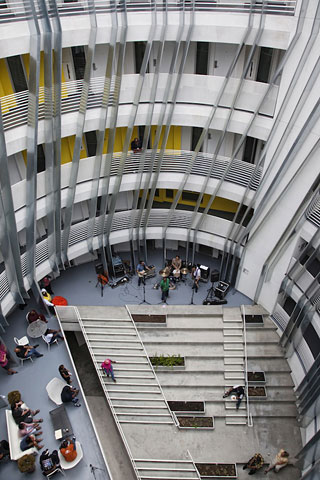








 405 bridge work causes a stink
405 bridge work causes a stink

